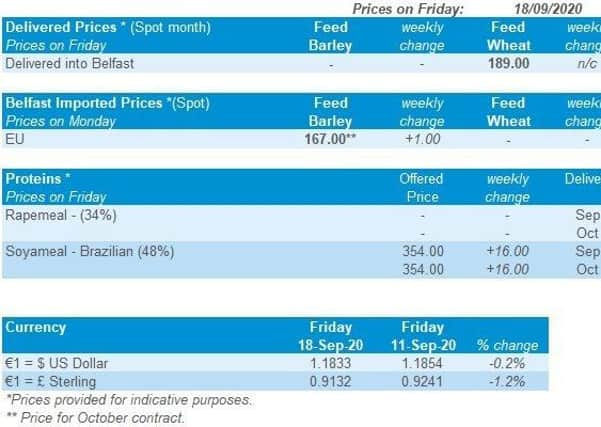Northern Ireland Weekly Market Report


21 September 2020
Grain Market Outlook Conference 2020
2020 has been a year of challenges for the arable sector, from a sharply lower planted area to the impacts of a global pandemic.
As we move forward into 2021, a longer-term view on the volatility of domestic and global grain markets is needed now more than ever.
Advertisement
Advertisement
This year the Grain Market Outlook Conference comes to you online via Microsoft Teams, ensuring you don’t miss out on critical market information.
Grains
Wheat
Global wheat stocks are still expected to be large despite cuts in production year-on-year in the USA, Ukraine and the EU. In the UK, a weak sterling is helping to support prices.
Maize
Chicago maize futures (Dec-20) have been showing signs of optimism. Whilst demand for imports from China remains strong, total production figures are still expected to be high, which may limit price rises.
Barley
Both domestic and global production of barley remain high. Feed barley continues to be priced at a notable discount to feed wheat.
Global markets
Advertisement
Advertisement
Global wheat prices have remained strong over the last week, with both Chicago and Paris wheat futures making strong gains towards the end of the trading week. Markets were support by rampant demand with tenders for wheat from a large volume of importing countries including Egypt, Jordan, Turkey and Saudi Arabia.
Despite this, global wheat production forecasts are still looking large, although the risk of La Niña weather event impacting crops in the Southern Hemisphere could limit further growth.
Furthermore, dryness in Argentina remains a key watch point for developing wheat crops.
Russian grain exports for September have been forecast at 5.65Mt by Russian agricultural consultancy SovEcon. Estimates for wheat and barley are both projected to have increased on August’s levels, whereas Russian maize exports are estimated to be slightly lower month-on-month.
Advertisement
Advertisement
Chinese demand for imports is still helping to support maize markets. There are also reports this week to suggest China is planning to expand its current stockpiling capacity of agricultural goods further in the near future, according to Refinitiv.
Ukraine’s export prices have also benefitted from this influx in demand from China, especially for barley. Similarly, APK-inform suggested Ukrainian prices for 12.5% milling wheat have risen by $9/t on the week. This price increase was also supported by concerns of poor weather impacting on early planting conditions in Ukraine.
UK focus
The weaker sterling compared to the euro and the US dollar is helping to support domestic prices. Sterling closed at £1=€1.091 on Friday, a slight increase on last week but still notably low.
UK feed wheat futures (Nov-20) closed at £179.25/t on Friday. After an initial decline earlier in the week, nearby prices pushed up to reach the highest levels since October 2018.
Advertisement
Advertisement
Whether the domestic market will be able to sustain these high prices is uncertain, especially with the current economic climate and political negotiations surrounding the UK’s withdrawal agreement from the EU. These factors have the potential to cause a period of increased market volatility.
Oilseeds
Rapeseed
With tight supplies of rapeseed globally, values will be held towards the top of the oilseed complex. Crop development in Australia and harvest progress in Canada will influence how high in the complex.
Soyabeans
Global soyabean stocks are tighter year-on-year, and firm demand for US exports has pushed values higher. The focus for soyabean values will be the imminent US soya harvest and planting in Brazil, as these will influence the outlook for prices into 2021.
Global markets
Soyabeans once again dominated the oilseeds complex last week, with Chinese purchases of the oilseed a key driver. Chicago soyabean futures (Nov-20) have now gained $32.62/t since the beginning of the month, closing on Friday at $383.42/t.
Advertisement
Advertisement
The USDA’s latest export sales figures showed 1.5Mt of net sales of soyabean to China in the week ending 10 September, with a further 499Kt to unknown origins. The US total commitment of soyabean exports in 2020/21 now stands at 32.3Mt.
With the US soyabean harvest imminent, close attention will be paid to yields. Meanwhile, plantings are due to get underway in Brazil soon, and as such, dry conditions will be monitored closely. Higher yields or area than expected could reduce support for prices, while lower yields or area will further support prices.
Support is also seen from other oilseeds. Sunflower oil values have seen significant support of late from lower yield prospects in the Black Sea region. UkrAgroConsult estimate that sunflower yields are down 21% year-on-year in Ukraine.
Palm oil futures have also had support. Suggestions that Indonesia may adopt a higher levy on palm oil exports prompted a flurry of demand for Malaysian palm oil (Refinitiv).
Advertisement
Advertisement
Alternative oilseeds are increasingly important for EU and UK oilseed price formation this season. The tight availability of rapeseed means we have an increased propensity to import oilseeds. EU-27 and UK imports of soyabeans (+2.5%), sunflower seeds (+30.4% from a low base) and palm oil (+4.8%) are all up year-on-year.
Rapeseed focus
Once again, rapeseed values followed the global trend in wider oilseed markets. Paris rapeseed futures (Nov-20) closed on Friday at €395.00/t, a rise of €12.75/t on the week and new contract high. With tight supplies of rapeseed globally, values will be held towards the top of the oilseed complex.
UK delivered rapeseed values have now increased £17.00/t in the last two weeks, with delivered Erith (Nov) was quoted on Friday £366.00/t. UK markets are continuing to track EU and global oilseed markets and developments in the value of sterling.
Last Monday the Canadian canola crop was forecast at 19.4Mt by the Canadian government, a reduction of 85Kt year-on-year but unchanged from the previous forecast. With the crop now being harvested, developments in Canadian weather will be watched closely.